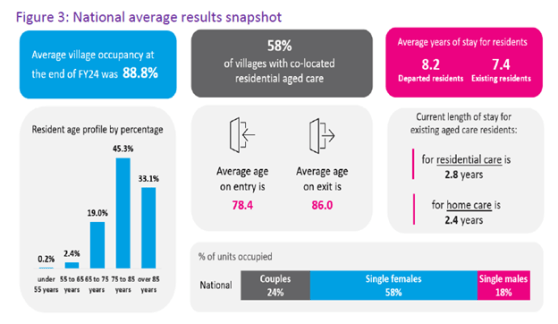StewartBrown’s Retirement Living Performance Survey Sector Report (FY24) shows a shift in the profile of Australian retirement villages, with the age of residents, their length of stay and the age of the villages themselves all increasing.
The report – which surveyed 79 operators and incorporated 455 retirement villages with 31,000 village units – is the first annual retirement living report for the financial benchmarking service.
Senior partner Grant Corderoy told Australian Ageing Agenda the decision to start surveying retirement villages stems from the increasing age of residents, as the demographic shift is pushing villages further toward becoming part of the care sector.
The average age of people entering retirement villages will likely continue to slowly increase but not by a lot, Mr Corderoy told AAA.

“But if you look at, say, home care packages, the average age is about 82, commonwealth home support is at 82, 83, residential aged care is probably 84, 85, so what we’re seeing with retirement living [is] it’s now getting into that same age bracket mix,” he said.
“So, there will be slight increases in the age… we forget that retirement living started its life as over 55s housing, and so it’s a long way from there.
“I suspect it’ll have incremental increases, but what is becoming more relevant is that retirement living is now becoming very much part of the care sector.”
According to the report, the average age of someone entering a retirement village is 78.4 years and the average exit age is 86, which Mr Corderoy told AAA is likely because people want the retirement village to be their last place of residence.
“So therefore, strategically, providers have now got to create an environment where the villages provide more care delivery, and move up towards 24-hour care… and design it so that hopefully people can remain in their homes, the villages, the units, rather than having to transition to residential aged care – which 50 per cent will, but they’ve got to now make that community much more, I think, care focused,” he said.

But with the report showing retirement villages are on average 30 years old, providers need to also start giving consideration to village assets and ensure they are maintained to support the older resident cohort’s needs.
Today, refurbishment at unit resale and upgrades to communal areas “are no longer optional,” the report noted. Villages instead need to ensure units can support an older demographic to age in place by providing both clinical care and wellbeing support.
Mr Corderoy said allied health is “a really key component” in delivering the necessary care to ageing residents in retirement villages.
“I think people see that the benefits of allied health – be it physiotherapy, occupational therapy, dietitian – are really important,” he said.
Providers also need to look at new developments or expanding, he added, as occupancy is going to continue rising as the population continues to age – with the report noting that national retirement village occupancy rate at the end of the 2024 financial year was 88.8 per cent.
Comment on the story below. Follow Australian Ageing Agenda on LinkedIn and Facebook, sign up to our twice-weekly newsletter and subscribe to AAA magazine for the complete aged care picture.









